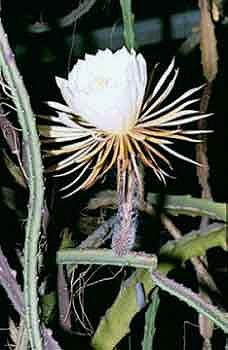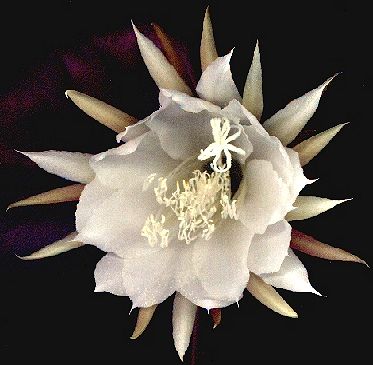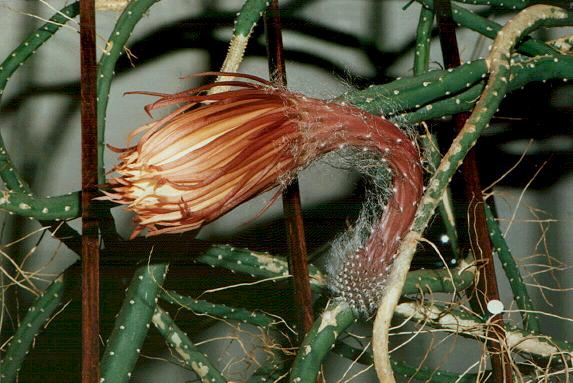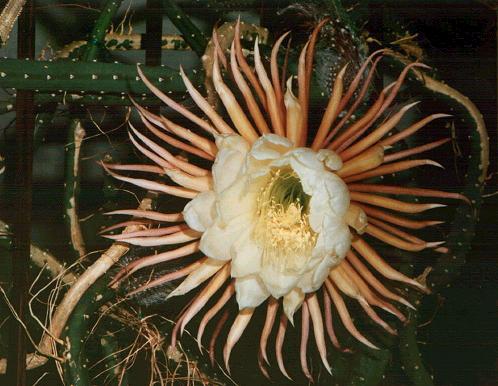Comments on my "wrong" Queen of the Night
E-mail 1:
Subject: Selenicereus grandiflorus
Date: Fri, 4 May 2001
Hi,
 I saw your pages looking for a good picture of Selenicereus grandiflorus,
the Queen of the Night.
I saw your pages looking for a good picture of Selenicereus grandiflorus,
the Queen of the Night.
The cactus you show is not Selenicereus
grandiflorus.
Selenicereus and the related genera Heliocereus, Disocactus,
Aporocactus, and Epiphyllum were used over a hundred years to make hybrids.
As you already suspect, your plant is definitely a hybrid. It is definitely
not Selenicereus grandiflorus. It may include Selenicereus, because the
flower shape is similar, but maybe not.
It could also be a development of
some Epiphyllum species. Selenicereus flowers are larger and the outer ring
of petals is more pronounced. The flowers open only at night. The body of
the plant looks completely different. Selenicereus makes cylindrical stems
that can be many meters long with about five ribs and many short spines. The
stems are never flat.
I attach a picture that I found somewhere.
I enjoyed your pages. They are very informative.
Alex Bunkenburg
===================
6 May 2001.
Hello Alex,
Thank you for your reaction, and the picture of the real Selenicereus grandiflorus.
Of course with a bit of regret that I hadn't the REAL Queen of the Night (so in English it has
this name indeed), I'll change my page before long, as I don't want to give false information.
Have you ever seen the plant in reality? Some Botanical Gardens have one.
I think, it's not
such a handy plant for just a livingroom like mine, with its very long stems. I must admit, that
I cut my plant down, because it wasn't too healthy in the ends, they turned yellow and had funny
holes in the stems. In the photos you only see the flat stems, but it was a plant with 2 sorts of
stems really - there were cylindrical bits of stem as well, sometimes between two flat parts.
Therefore I suppose my plant did have Selenicereus in it. To my regret it died last year,
so I can't have an investigating look at it any more.
You sent me this picture - I suppose it originates from a site where they also discussed the plant.
Can you give me the address, I'd like to have a look there too. If you found any other addresses
on the same subject, could you please give them to me? Perhaps it's worthwhile to put a link on my
site to compare my plant with the REAL one...
I have a description of Selenicereus in a book (± 25-30 years old) about cactuses and succulents,
a Dutch translation of the German book "Schöne Kakteen und andere Sukkulenten" by Werner Rauh. Indeed it
says the stems should be cylindrical.
I hope to hear from you again.
Kind regards,
Irene de Boer
===================
Monday, May 07, 2001 12:35 PM
Subject: Re: Selenicereus grandiflorus
Hello Irene
The plant is not rare.
I used to have it when I lived in Germany. If you're
looking for it, I suppose most of the cactus shops (Haage, Uhlig, etc) sell
it.
Look at the cactus mall: http://www.cactus-mall.com/.
Although the plant becomes huge (many meters) you can grow it in a pot at home. You have to cut
it sometimes.... and it will flower before it becomes too big for the
windowsill.
I don't remember where I got the picture from. I spent some time surfing and
searching.
But you can maybe find it and other links about it yourself.
Alex
==========================================================================
E-mail 2:
Subject: Queen of the Night
Date: Tue, 22 May 2001
I just came across your site Herbarium and thought I should send a note.
The plant you call Selenicereus grandiflorus is in fact an Epiphyllum (Epiphyllum crenatum var. kimnachii 'Cooperii').
For more information:
http://members.nbci.com/iconesepiphyticum/species/Selenicereus/grandiflorum.htm
(Selenicereus grandiflorus)
http://members.nbci.com/iconesepiphyticum/species/Epiphyllum/crenatum.htm
(Epiphyllum crenatum).
(Alas, these URLs don't work anymore - Aug 2002)
Ulf Eliasson
===================
24 May 2001

Thank you for telling me the right name of this plant.
I already got another e-mail from somebody who said it was not Selenicereus, but he couldn't tell me what it really should be.
I'll change the name as soon as I have time to update - within a week, I suppose.
You've got an interesting site too.
Do you not have a photo of the exact same plant I have?
Those pictures of Epiphyllum crenatum var. crenatum looked a lot like it too, but there must be a slight difference, I understand.
Kind regards,
Irene de Boer
==========================================================================
E-mail 3:
Subject: Queen of the Night
Date: Fri, 08 Jun 2001 20:13:52
Hello,
I have seen your site on Selenicereus grandiflorus and the rectification.
Don't be too disappointed. This is a very common mistake.
Word to the wise never identify a plant from its common name.
That is when the latin names come in handy.
You see "Queen of the Night", "Night Blooming Cereus", "Princess of the Night" and
even "King of the Night" are all common names that are attributed to all, very large,
white, night blooming cacti flowers. Therefore you have to be very careful.
Also always identify a plant by both the plant itself and the flower.
Never plant alone or flower alone.
Also as a rule if it says the flower is between 20 and 30 cm if the one you have is not
in these proportions there is a good chance you have a different variety.
I too was handed a plant from someone I knew who told me what they were giving me was a
S. grandiflorus. Mine turned out to be Epiphyllum oxypetalum.
Here are a few sites you may want to visit to see a true Selenicereus grandiflorus and other
Selenicereus species:
http://www.gardens.co.nz:80/PlantoftheWeek.cfm?NLID=138
www.viridis.net/cactus/sel_mac.html
Botanischer Garten der Universität Basel - Selenicereus grandiflorus
www.desert-tropicals.com/Plants/Cactaceae/Selenicereus.html
After looking at these sites I want one of each!!!
Good hunting!
Suzanne Blake
President of the Montreal Cactus Group in Canada.
===================
18 June 2001.
Hello Suzanne,
Thank you for your letter.
I didn't know there were so many more-or-less "look-alikes" of the Queen of the Night - Selenicereus grandiflorus.
In the meantime I also heard from the friend I got the plant from, that she already knows it's an Epiphyllum. The diameter of the flower simply is too small, and it blooms too long for a Queen of the Night, which I really don't think a disadvantage.
I was a little late in answering you, having been very busy in my garden during the last two weeks, and I couldn't find the time yet to have a look at the URLs you gave me, but being very much interested, I thought I'd have to see these first before answering you.
This morning I visited all four of them, and I must say they're magnificent.
The Swiss one with the whole photo-story from beginning of the bud till the fading of the flower, is very informative (also the German text), and the other links also have a few lovely pictures from which I can learn again.
What also strikes me, is that the pistil of Selenicereus grandiflorus is much more inpressive and with a bigger and more compound stigma than the one in my plant, and that the buds are so hairy.
Thanks a lot for these URLs, I'll put your e-mail with these 4 links on my page with reactions too.
Kind regards,
Irene de Boer
==========================================================================
E-mail 4:
 Subject: Selenicereus grandiflora
Subject: Selenicereus grandiflora
Date: Tue, 10 Jul 2001 21:20:46
Dear Irene de Boer,
By accident I encountered your website with your beautiful "non queen of the
night".
Since many years I have a "real" Selenicereus grandiflora, a 1987
cutting of a 1974 cutting of a now very old aunt of mine....
To keep the plant more or less under control I wind it around a wooden frame and cut
it when necessary. Nevertheless, the plant so now and then falls on the
floor as you possibly can imagine. The position is in a window on the SE
side of our central-heated main room. I do not give it any special
treatment. Normal water once a week, no fertilizers or whatever and since
1995 it flowers every year at least once but almost always during my
holidays.
Three days ago I was lucky: the bud had grown to about 20 cm in
two days, in the beginning of the afternoon a first sign of opening was
visible and from 19:00 hours it started to open. It diffused a slight fresh
(lemon like?) scent. Full open at 23:00 hours. Next morning completely
closed.
To cheer you up I enclose two pictures I made in 1985, the other time I was
lucky and not on holiday. Number 1 was taken before the opening, the other
at 23:00.
If you are interested you can surely get cuttings from me, send me
your address, but please, do not send me the whole succulent club on my
roof...
 With kind regards,
With kind regards,
Jos Henrichs
De echte Koningin van de Nacht in ons park (2002) / Real 'Queen of the Night' in our park (2002)
Mijn eigen echte Koningin van de Nacht (2003) / My own real 'Queen of the Night' (2003)
==========================================================================


